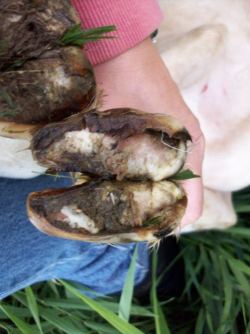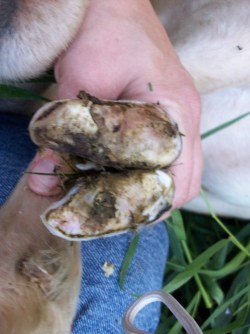These pictures have been sitting around for a while, as I finished hanging gates in the first field months ago. But, since I had a hard time developing a strategy for hanging big gates, I thought I’d share what I came up with.
The first time I tried it, I found the gates to be very awkward and unwieldy to handle. Trying to hold them up to the posts and just mark where they should go does not work! Especially if you are doing it solo and don’t have a helper, which is often the case for me. I needed a more accurate system. Uneven ground increased the challenge: I prefer my gates to be fairly low to the ground so the dogs can’t get under, but they need to be high enough to swing easily, even over time as they sag.
 What I found worked well was to use a “string level” to determine where I wanted to position the bottom of the gate. These are inexpensive tiny levels that hang on a piece of string, as shown in the picture.
What I found worked well was to use a “string level” to determine where I wanted to position the bottom of the gate. These are inexpensive tiny levels that hang on a piece of string, as shown in the picture.
They aren’t perfectly accurate, but if you position it roughly in the middle of the stretch of string, it’s good enough guidance to let you visualize where the bottom of the gate will be. Once I decided where the bottoms of each gate post went, I marked that on the posts. Then I measured up to where the bottom bracket should be in relation to the bottom of the gate posts, and drilled a hole for that bracket’s hanging bolt. From that bolt, I’d measure upwards to determine the position of the top bracket’s bolt. Here is a picture of the string level marking the gate’s bottom:
The trick with most of these gate hinges is they are intended for the bolt “finials” (this is not the right word, but I’m not sure what the correct term should be…) point towards each other. This is counter-intuitive to some, and if you don’t plan right, you won’t end up being able to achieve this. The biggest reason for them pointing towards each other is: if, for example, a strong cow got her horns hooked in the gate and pulled upwards, you wouldn’t want her to be able to slide the gate right off the bolts. So, having the top “finial” point downwards prevents the gate from being removable in this fashion. (You could imagine that it makes it less trivial for thieves to break in too, but it’s still simple for them to break in: they can just unscrew the hinge bolts, or snip right through your fence wire!)
 To make sure you can have the top finial pointing downward, it’s important to place the top bolt high enough that you can have the hinge positioned lower on the gate that the bolt’s “finial” and then slide it up onto the “finial”. Err on the side of putting the bolt too high than too low. Once the hinge bracket is on the finial, you tighten the bolts down, and the weight of the gate is actually pulling mostly sideways against this “finial” (thus it doesn’t need to sit “down” on an upward-pointing “finial”- only the bottom hinge needs to do that). I had a couple of cases where I didn’t plan right, or had another object in the way, and ended up with the top “finial” pointing upwards. It turns out, it works OK as long as the gate is a big one– the weight of the gate still “binds” it plenty on the hinge bolt to where even a lot of force won’t slide it up and off the bolts. But, this would not be true for smaller gates.
To make sure you can have the top finial pointing downward, it’s important to place the top bolt high enough that you can have the hinge positioned lower on the gate that the bolt’s “finial” and then slide it up onto the “finial”. Err on the side of putting the bolt too high than too low. Once the hinge bracket is on the finial, you tighten the bolts down, and the weight of the gate is actually pulling mostly sideways against this “finial” (thus it doesn’t need to sit “down” on an upward-pointing “finial”- only the bottom hinge needs to do that). I had a couple of cases where I didn’t plan right, or had another object in the way, and ended up with the top “finial” pointing upwards. It turns out, it works OK as long as the gate is a big one– the weight of the gate still “binds” it plenty on the hinge bolt to where even a lot of force won’t slide it up and off the bolts. But, this would not be true for smaller gates.
Here are two gates where I was pretty happy with their final hanging height and smooth ability to swing in both directions. I had one gate opening that ended up being too narrow, so the gate only opens inward. I can live with that, but much prefer them to go both ways. It just makes it convenient to get vehicles and animals in and out when the gate can move in the direction that’s most accommodating to the flow of movement.
In case my use of the word “finial” isn’t clear, here is a photo of the part of the bolt I’m referring to (in the red circle). In this photo, the hinge and bolt are positioned as they are when you purchase the gate, such that they won’t fall off during transport. You have to swing the hinge around 180°, which can be tricky. I find that I need to bring several extra tools down to the field for this purpose: a big screwdriver for leverage, some channel locks, extra pliers and a hammer. It seems it’s worse on these mesh gates, as sometimes the hinge gets hung up on the wire. On some I had to completely remove it and then re-attach it in the other direction. It takes a lot of force to bend them enough to get them off, and then narrow them back up again to re-bolt them in their final position.









